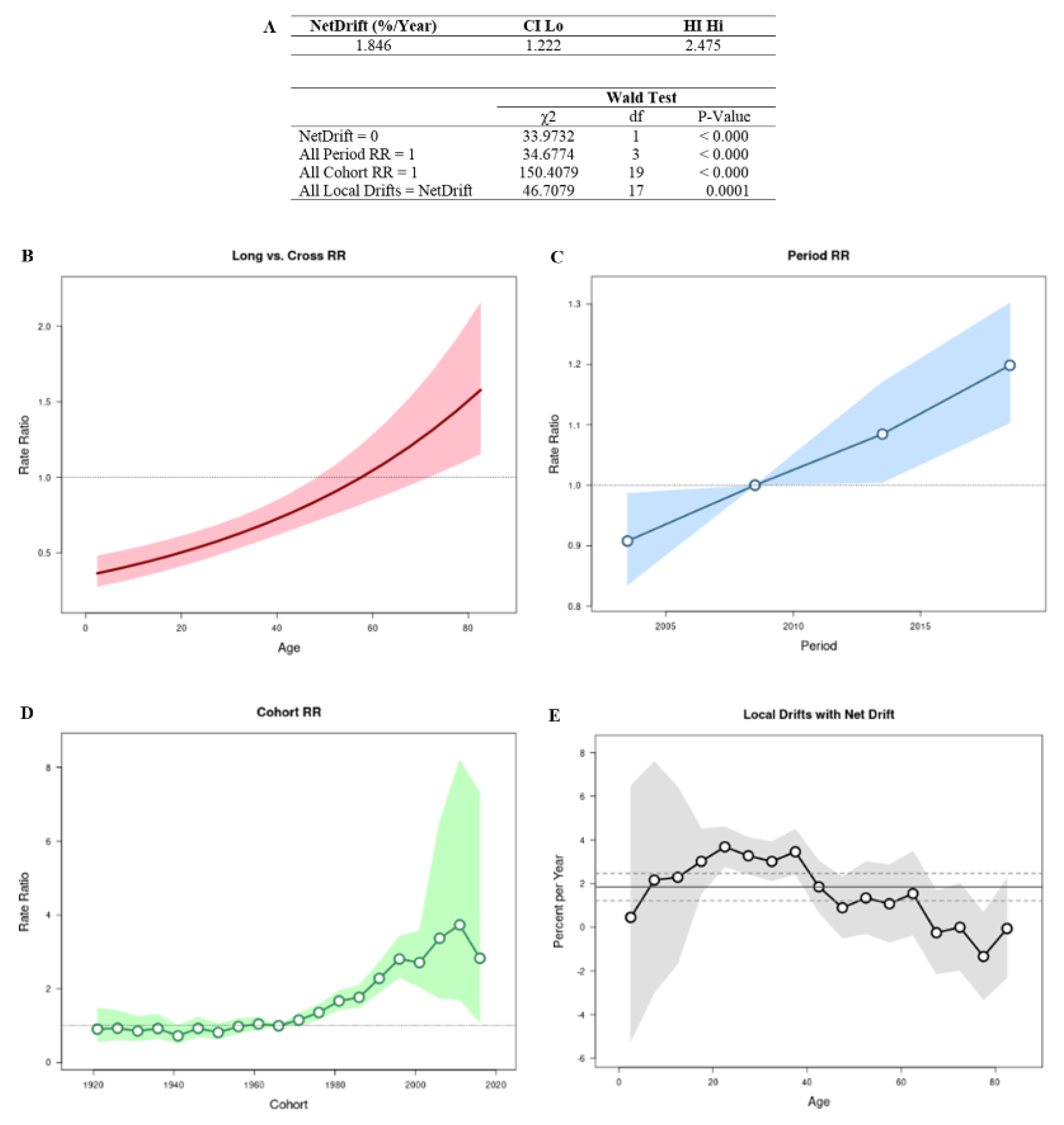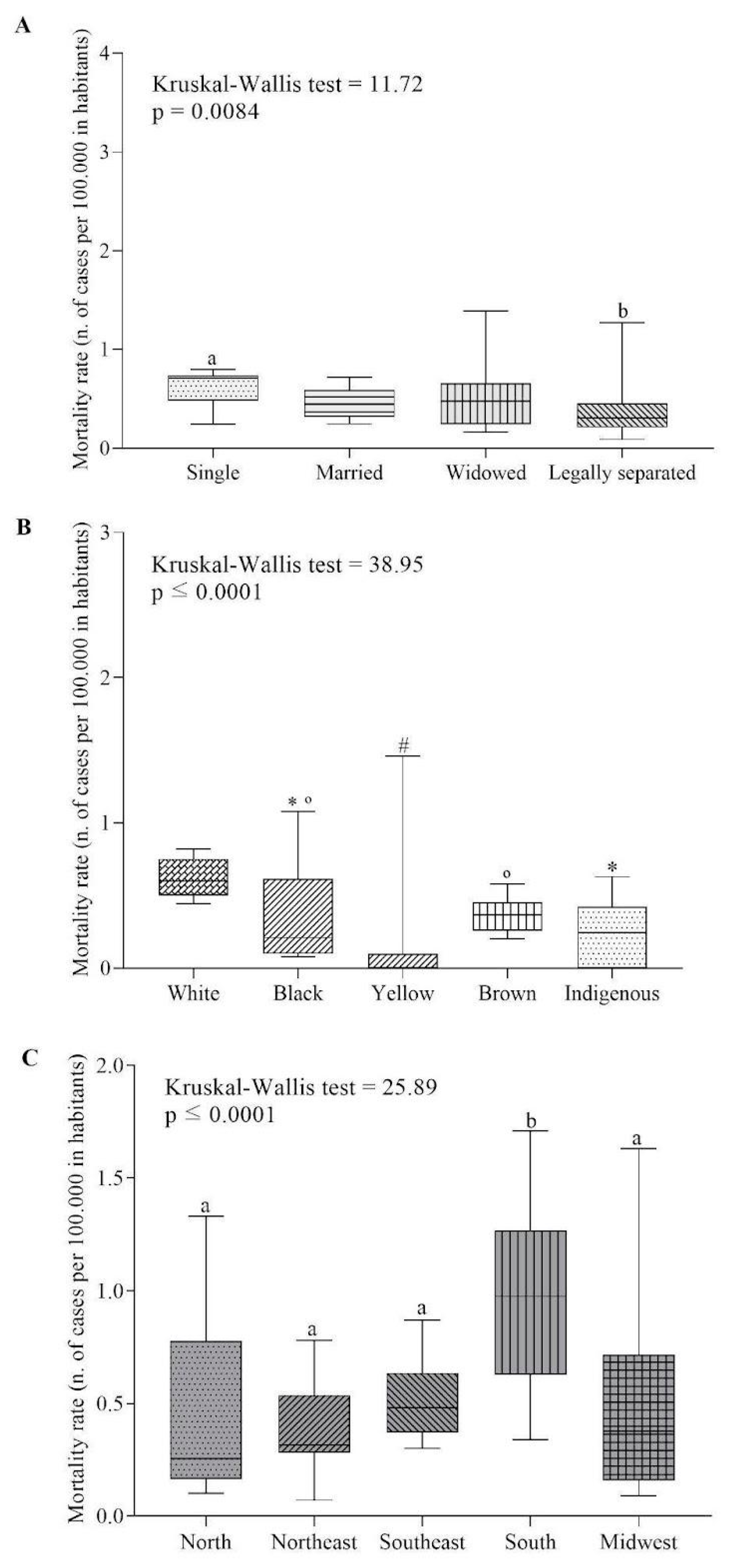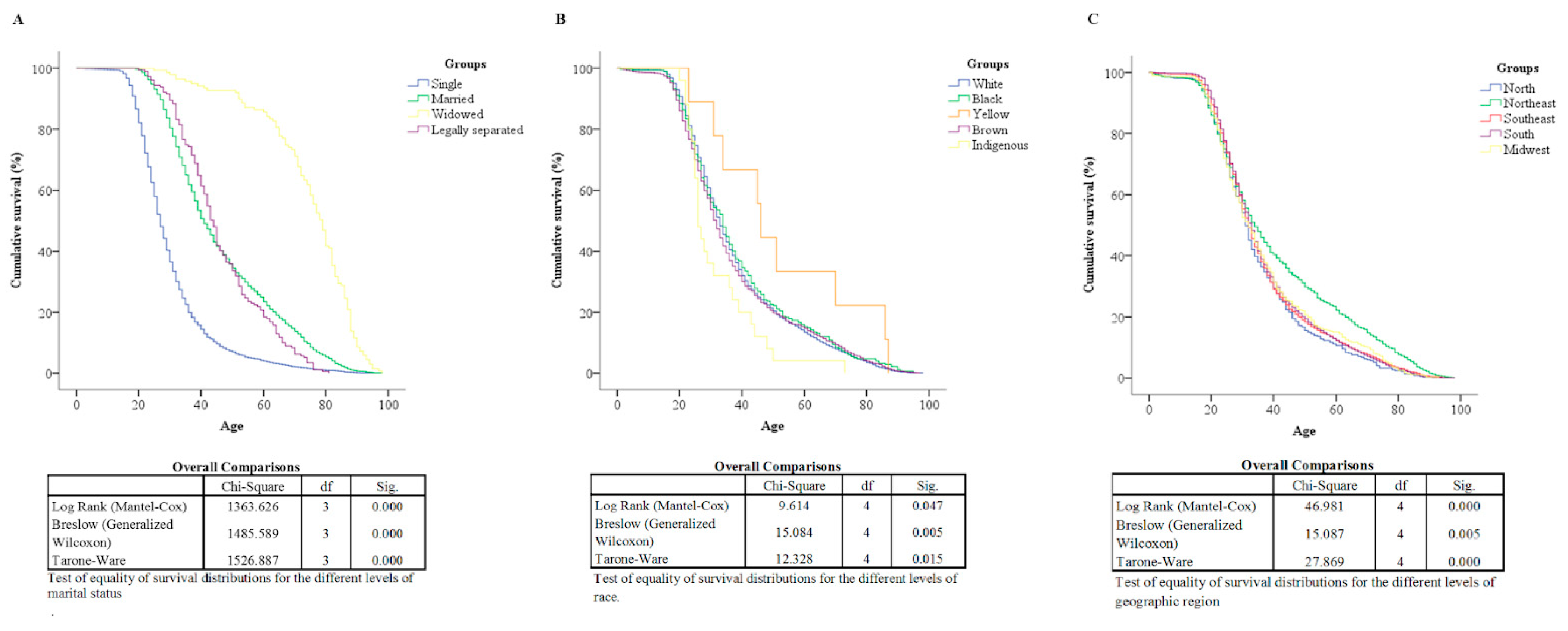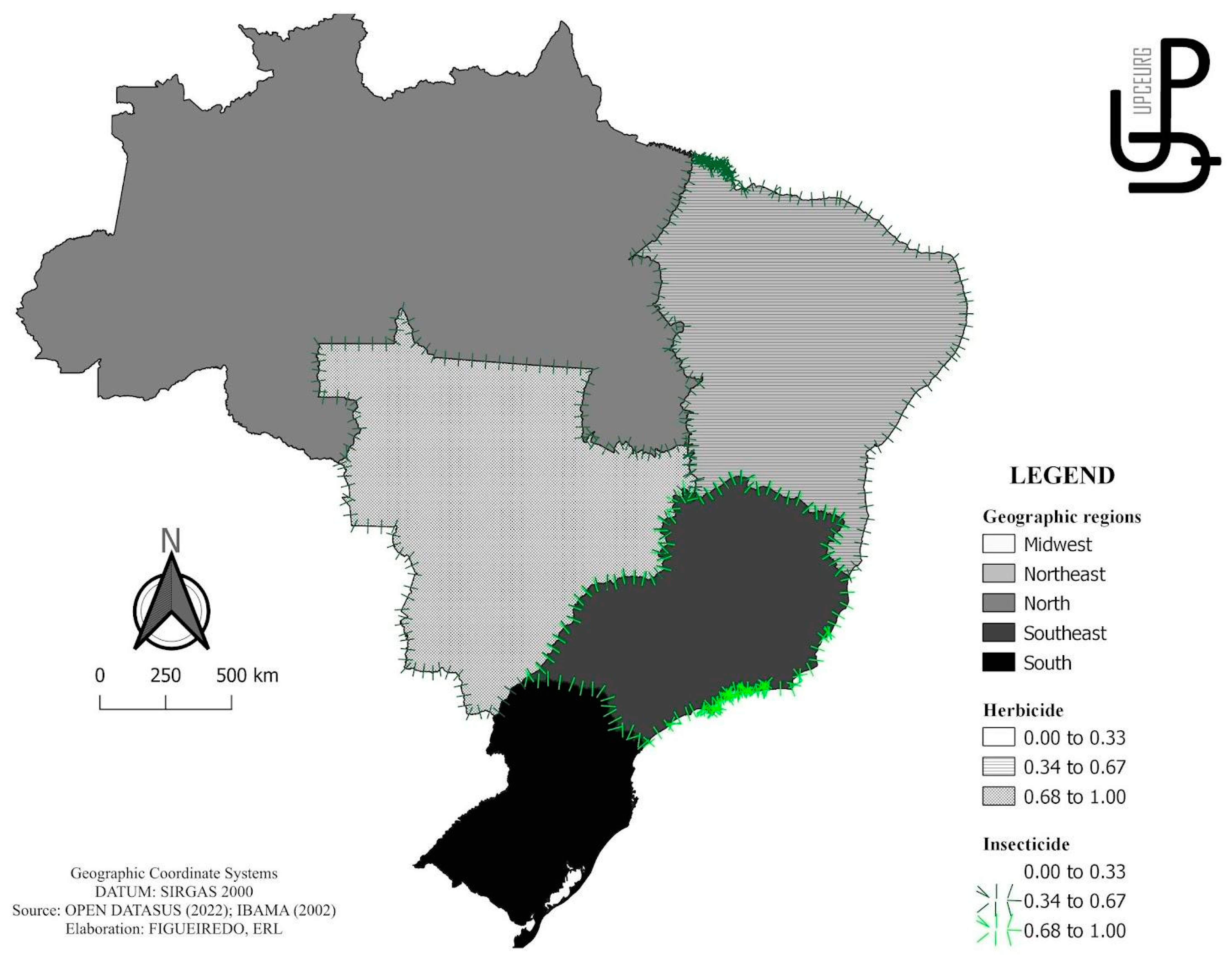Predictors of Testicular Cancer Mortality in Brazil: A 20-Year Ecological Study
Abstract
:Simple Summary
Abstract
1. Introduction
2. Materials and Methods
2.1. Ethical Aspects
2.2. Type of Study
2.3. Population
2.4. Eligibility Criteria
2.5. Database
2.6. Outcomes
2.7. Statistical Analysis
3. Results
3.1. Age–Period–Cohort Effect
3.2. Sociodemographic Factors
3.3. Survival Analysis
3.4. ASMR and Risk Factors, Diagnosis, and Treatment
4. Discussion
5. Conclusions
Author Contributions
Funding
Institutional Review Board Statement
Informed Consent Statement
Data Availability Statement
Conflicts of Interest
References
- Gaddam, S.J.; Chesnut, G.T. Testicle Cancer. In StatPearls; StatPearls Publishing: Treasure Island, FL, USA, 2023. [Google Scholar]
- Cassell, A.; Jalloh, M.; Ndoye, M.; Yunusa, B.; Mbodji, M.; Diallo, A.; Gaye, O.; Labou, I.; Niang, L.; Gueye, S. Review of Testicular Tumor: Diagnostic Approach and Management Outcome in Africa. Res. Rep. Urol. 2020, 12, 35–42. [Google Scholar] [CrossRef]
- Mele, T.; Reid, A.; Huddart, R. Recent Advances in Testicular Germ Cell Tumours. Fac. Rev. 2021, 10, 67. [Google Scholar] [CrossRef]
- Rajpert-De Meyts, E.; Aksglaede, L.; Bandak, M.; Toppari, J.; Jørgensen, N. Testicular Cancer: Pathogenesis, Diagnosis, and Management with Focus on Endocrine Aspects. In Endotext; Feingold, K.R., Anawalt, B., Blackman, M.R., Boyce, A., Chrousos, G., Corpas, E., de Herder, W.W., Dhatariya, K., Dungan, K., Hofland, J., et al., Eds.; MDText.com, Inc.: South Dartmouth, MA, USA, 2000. [Google Scholar]
- Williamson, S.R.; Delahunt, B.; Magi-Galluzzi, C.; Algaba, F.; Egevad, L.; Ulbright, T.M.; Tickoo, S.K.; Srigley, J.R.; Epstein, J.I.; Berney, D.M.; et al. The World Health Organization 2016 Classification of Testicular Germ Cell Tumours: A Review and Update from the International Society of Urological Pathology Testis Consultation Panel. Histopathology 2017, 70, 335–346. [Google Scholar] [CrossRef]
- PDQ Adult Treatment Editorial Board Testicular Cancer Treatment (PDQ®): Patient Version. In PDQ Cancer Information Summaries; National Cancer Institute (US): Bethesda, MD, USA, 2002.
- Ondrusova, M.; Ondrus, D. Epidemiology and Treatment Delay in Testicular Cancer Patients: A Retrospective Study. Int. Urol. Nephrol. 2008, 40, 143–148. [Google Scholar] [CrossRef]
- Mrinakova, B.; Trebaticky, B.; Kajo, K.; Ondrusova, M.; Lehotska, V.; Waczulikova, I.; Ondrus, D. Bilateral Testicular Germ Cell Tumors–50 Years Experience. Bratisl. Lek. Listy 2021, 122, 449–453. [Google Scholar] [CrossRef]
- Lip, S.Z.L.; Murchison, L.E.D.; Cullis, P.S.; Govan, L.; Carachi, R. A Meta-Analysis of the Risk of Boys with Isolated Cryptorchidism Developing Testicular Cancer in Later Life. Arch. Dis. Child. 2013, 98, 20–26. [Google Scholar] [CrossRef]
- Landero-Huerta, D.A.; Vigueras-Villaseñor, R.M.; Yokoyama-Rebollar, E.; García-Andrade, F.; Rojas-Castañeda, J.C.; Herrera-Montalvo, L.A.; Díaz-Chávez, J.; Pérez-Añorve, I.X.; Aréchaga-Ocampo, E.; Chávez-Saldaña, M.D. Cryptorchidism and Testicular Tumor: Comprehensive Analysis of Common Clinical Features and Search of SNVs in the KIT and AR Genes. Front. Cell Dev. Biol. 2020, 8, 762. [Google Scholar] [CrossRef]
- Cheng, L.; Albers, P.; Berney, D.M.; Feldman, D.R.; Daugaard, G.; Gilligan, T.; Looijenga, L.H.J. Testicular Cancer. Nat. Rev. Dis. Prim. 2018, 4, 29. [Google Scholar] [CrossRef]
- Znaor, A.; Lortet-Tieulent, J.; Jemal, A.; Bray, F. International Variations and Trends in Testicular Cancer Incidence and Mortality. Eur. Urol. 2014, 65, 1095–1106. [Google Scholar] [CrossRef]
- Bessa Dantas, D.; da Costa, D.; Andrade, E.; Bastos, M.D.S.; Gomes, F.; de Melo-Neto, J.S. Sociodemographic and Clinical Factors Associated with Cryptorchidism in Live Births in Brazil: A 20-Year Analysis. J. Public Health Res. 2021, 10, jphr-2021. [Google Scholar] [CrossRef]
- Faja, F.; Esteves, S.; Pallotti, F.; Cicolani, G.; Di Chiano, S.; Delli Paoli, E.; Lenzi, A.; Lombardo, F.; Paoli, D. Environmental Disruptors and Testicular Cancer. Endocrine 2022, 78, 429–435. [Google Scholar] [CrossRef]
- Cremonese, C.; Freire, C.; Meyer, A.; Koifman, S. Exposição a agrotóxicos e eventos adversos na gravidez no Sul do Brasil, 1996-2000. Cad. Saúde Pública 2012, 28, 1263–1272. [Google Scholar] [CrossRef]
- Kaur, R.P.; Gupta, V.; Christopher, A.F.; Bansal, P. Potential Pathways of Pesticide Action on Erectile Function—A Contributory Factor in Male Infertility. Asian Pac. J. Reprod. 2015, 4, 322–330. [Google Scholar] [CrossRef]
- Ferguson, L.; Agoulnik, A.I. Testicular Cancer and Cryptorchidism. Front. Endocrinol. 2013, 4, 32. [Google Scholar] [CrossRef]
- Souza, K.W.D.; Reis, P.E.D.D.; Gomes, I.P.; Carvalho, E.C.D. Estratégias de prevenção para câncer de testículo e pênis: Revisão integrativa. Rev. Esc. Enferm. USP 2011, 45, 277–282. [Google Scholar] [CrossRef]
- Pietrzyk, Ł.; Denisow-Pietrzyk, M.; Czeczelewski, M.; Ślizień-Kuczapski, K.; Torres, K. Cancer Education Matters: A Report on Testicular Cancer Knowledge, Awareness, and Self-Examination Practice among Young Polish Men. Sci. Rep. 2020, 10, 20684. [Google Scholar] [CrossRef]
- Chovanec, M.; Cheng, L. Advances in Diagnosis and Treatment of Testicular Cancer. BMJ 2022, 379, e070499. [Google Scholar] [CrossRef]
- Gilligan, T.; Lin, D.W.; Aggarwal, R.; Chism, D.; Cost, N.; Derweesh, I.H.; Emamekhoo, H.; Feldman, D.R.; Geynisman, D.M.; Hancock, S.L.; et al. Testicular Cancer, Version 2.2020, NCCN Clinical Practice Guidelines in Oncology. J. Natl. Compr. Canc. Netw. 2019, 17, 1529–1554. [Google Scholar] [CrossRef]
- Xiao, F.; Shi, J.-Z.; Liu, Y.; Liu, T.; Wang, J.; Liu, Y.-S.; Wang, J.-K.; Wang, L.-H. Radical and Testis-Sparing Surgery for Primary Testicular Tumors: A Single-Center Experience. Mol. Clin. Oncol. 2019, 10, 343–351. [Google Scholar] [CrossRef]
- Bazzi, W.M.; Raheem, O.A.; Stroup, S.P.; Kane, C.J.; Derweesh, I.H.; Downs, T.M. Partial Orchiectomy and Testis Intratubular Germ Cell Neoplasia: World Literature Review. Urol. Ann. 2011, 3, 115–118. [Google Scholar] [CrossRef]
- Feldman, D.R.; Bosl, G.J.; Sheinfeld, J.; Motzer, R.J. Medical Treatment of Advanced Testicular Cancer. JAMA 2008, 299, 672–684. [Google Scholar] [CrossRef] [PubMed]
- Kalavska, K.; Schmidtova, S.; Chovanec, M.; Mego, M. Immunotherapy in Testicular Germ Cell Tumors. Front. Oncol. 2020, 10, 573977. [Google Scholar] [CrossRef] [PubMed]
- Harris, K.A.; Reese, D.M. Treatment Options in Hormone-Refractory Prostate Cancer: Current and Future Approaches. Drugs 2001, 61, 2177–2192. [Google Scholar] [CrossRef]
- Conselho Nacional de Saúde. Resolução 510, de 7 de Abril de 2016. Diário Oficial da União. 2016. Available online: https://bvsms.saude.gov.br/bvs/saudelegis/cns/2016/res0510_07_04_2016.html (accessed on 12 June 2023).
- Thiese, M.S. Observational and Interventional Study Design Types; an Overview. Biochem. Med. 2014, 24, 199–210. [Google Scholar] [CrossRef] [PubMed]
- Ministério da Saúde. DATASUS. 2023. Available online: http://www2.datasus.gov.br/DATASUS/index.php?area=02 (accessed on 12 June 2023).
- IBGE. Cidades e Estados. 2022. Available online: https://www.ibge.gov.br/cidades-e-estados/ (accessed on 12 June 2022).
- IBGE. Relatórios de comercialização de agrotóxicos. 2023. Available online: https://www.gov.br/ibama/pt-br/assuntos/quimicos-e-biologicos (accessed on 12 June 2023).
- Rosenberg, P.S.; Check, D.P.; Anderson, W.F. A Web Tool for Age-Period-Cohort Analysis of Cancer Incidence and Mortality Rates. Cancer Epidemiol Biomark. Prev. 2014, 23, 2296–2302. [Google Scholar] [CrossRef] [PubMed]
- Hernandez, J.B.R.; Kim, P.Y. Epidemiology Morbidity and Mortality. In StatPearls; StatPearls Publishing: Treasure Island, FL, USA, 2023. [Google Scholar]
- Soares, S.C.M.; dos Santos, K.M.R.; de Morais Fernandes, F.C.G.; Barbosa, I.R.; de Souza, D.L.B. Testicular Cancer Mortality in Brazil: Trends and Predictions until 2030. BMC Urol. 2019, 19, 59. [Google Scholar] [CrossRef]
- Barbosa, I.R.; de Souza, D.L.; Bernal, M.M.; do CC Costa, Í. Cancer Mortality in Brazil: Temporal Trends and Predictions for the Year 2030. Medicine 2015, 94, e746. [Google Scholar] [CrossRef]
- McGlynn, K.A.; Trabert, B. Adolescent and Adult Risk Factors for Testicular Cancer. Nat. Rev. Urol. 2012, 9, 339–349. [Google Scholar] [CrossRef]
- Yazici, S.; Del Biondo, D.; Napodano, G.; Grillo, M.; Calace, F.P.; Prezioso, D.; Crocetto, F.; Barone, B. Risk Factors for Testicular Cancer: Environment, Genes and Infections—Is It All? Medicina 2023, 59, 724. [Google Scholar] [CrossRef]
- Antunes, J.L.F.; Toporcov, T.N.; Biazevic, M.G.H.; Boing, A.F.; Bastos, J.L. Gender and Racial Inequalities in Trends of Oral Cancer Mortality in Sao Paulo, Brazil. Rev. Saúde Pública 2013, 47, 470–478. [Google Scholar] [CrossRef]
- Barbosa, I.R.; Costa, Í.D.C.C.; Bernal, M.M.; de Souza, D.L.B. Tendência das Taxas de Mortalidade Pelas dez Principais Causas de Óbitos por Câncer no Brasil, 1996–2012. Rev. Ciência Plur. 2016, 2, 3–16. [Google Scholar] [CrossRef]
- Li, Y.; Lu, Q.; Wang, Y.; Ma, S. Racial Differences in Testicular Cancer in the United States: Descriptive Epidemiology. BMC Cancer 2020, 20, 284. [Google Scholar] [CrossRef]
- Pyle, L.C.; Nathanson, K.L. Genetic Changes Associated with Testicular Cancer Susceptibility. Semin. Oncol. 2016, 43, 575–581. [Google Scholar] [CrossRef] [PubMed]
- Akinyemiju, T.; Moore, J.X.; Pisu, M.; Lakoski, S.G.; Shikany, J.; Goodman, M.; Judd, S.E. A Prospective Study of Dietary Patterns and Cancer Mortality among Blacks and Whites in the REGARDS Cohort. Int. J. Cancer 2016, 139, 2221–2231. [Google Scholar] [CrossRef] [PubMed]
- Krajc, K.; Miroševič, Š.; Sajovic, J.; Klemenc Ketiš, Z.; Spiegel, D.; Drevenšek, G.; Drevenšek, M. Marital Status and Survival in Cancer Patients: A Systematic Review and Meta-Analysis. Cancer Med. 2023, 12, 1685–1708. [Google Scholar] [CrossRef]
- Feng, Y.; Dai, W.; Li, Y.; Mo, S.; Li, Q.; Cai, S. The Effect of Marital Status by Age on Patients with Colorectal Cancer over the Past Decades: A SEER-Based Analysis. Int. J. Colorectal. Dis. 2018, 33, 1001–1010. [Google Scholar] [CrossRef]
- Wang, L.; Wilson, S.E.; Stewart, D.B.; Hollenbeak, C.S. Marital Status and Colon Cancer Outcomes in US Surveillance, Epidemiology and End Results Registries: Does Marriage Affect Cancer Survival by Gender and Stage? Cancer Epidemiol. 2011, 35, 417–422. [Google Scholar] [CrossRef] [PubMed]
- Butow, P.N.; Coates, A.S.; Dunn, S.M. Psychosocial Predictors of Survival in Metastatic Melanoma. J. Clin. Oncol. 1999, 17, 2256–2263. [Google Scholar] [CrossRef]
- Tyson, M.D.; Andrews, P.E.; Etzioni, D.A.; Ferrigni, R.G.; Humphreys, M.R.; Swanson, S.K.; Castle, E.K. Marital Status and Prostate Cancer Outcomes. Can. J. Urol. 2013, 20, 6702–6706. [Google Scholar] [CrossRef] [PubMed]
- Aizer, A.A.; Chen, M.-H.; McCarthy, E.P.; Mendu, M.L.; Koo, S.; Wilhite, T.J.; Graham, P.L.; Choueiri, T.K.; Hoffman, K.E.; Martin, N.E.; et al. Marital Status and Survival in Patients with Cancer. J. Clin. Oncol. 2013, 31, 3869–3876. [Google Scholar] [CrossRef]
- FAOSTAT. Available online: https://www.fao.org/faostat/en/#data/RP/visualize (accessed on 12 June 2023).
- Liu, Y.; Xia, Q.; Xia, J.; Zhu, H.; Jiang, H.; Chen, X.; Zheng, Y.; Zhang, F.; Li, S. The Impact of Marriage on the Overall Survival of Prostate Cancer Patients: A Surveillance, Epidemiology, and End Results (SEER) Analysis. Can. Urol. Assoc. J. 2019, 13, E135. [Google Scholar] [CrossRef]
- Moses, K.A.; Orom, H.; Brasel, A.; Gaddy, J.; Underwood, W., III. Racial/Ethnic Disparity in Treatment for Prostate Cancer: Does Cancer Severity Matter? Urology 2017, 99, 76–83. [Google Scholar] [CrossRef]
- World Health Organization. Available online: https://www.who.int (accessed on 12 June 2023).
- Panis, C.; Kawassaki, A.C.B.; Crestani, A.P.J.; Pascotto, C.R.; Bortoloti, D.S.; Vicentini, G.E.; Lucio, L.C.; Ferreira, M.O.; Prates, R.T.C.; Vieira, V.K.; et al. Evidence on Human Exposure to Pesticides and the Occurrence of Health Hazards in the Brazilian Population: A Systematic Review. Front. Public Health 2021, 9, 787438. [Google Scholar] [CrossRef]
- de Rezende Chrisman, J.; Koifman, S.; de Novaes Sarcinelli, P.; Moreira, J.C.; Koifman, R.J.; Meyer, A. Pesticide Sales and Adult Male Cancer Mortality in Brazil. Int. J. Hyg. Environ. Health 2009, 212, 310–321. [Google Scholar] [CrossRef]
- de F. Sousa, M.G.; da Silva, A.C.; Dos Santos Araújo, R.; Rigotto, R.M. Evaluation of the Atmospheric Contamination Level for the Use of Herbicide Glyphosate in the Northeast Region of Brazil. Environ. Monit. Assess. 2019, 191, 604. [Google Scholar] [CrossRef]
- Rigotto, R.M.; Silva, A.M.C.; da Ferreira, M.J.M.; Rosa, I.F.; Aguiar, A.C.P. Trends of Chronic Health Effects Associated to Pesticide Use in Fruit Farming Regions in the State of Ceará, Brazil. Rev. Bras. Epidemiol. 2013, 16, 763–773. [Google Scholar] [CrossRef]
- Lopes-Ferreira, M.; Maleski, A.L.A.; Balan-Lima, L.; Bernardo, J.T.G.; Hipolito, L.M.; Seni-Silva, A.C.; Batista-Filho, J.; Falcao, M.A.P.; Lima, C. Impact of Pesticides on Human Health in the Last Six Years in Brazil. Int. J. Environ. Res. Public Health 2022, 19, 3198. [Google Scholar] [CrossRef]
- Sifakis, S.; Androutsopoulos, V.P.; Tsatsakis, A.M.; Spandidos, D.A. Human Exposure to Endocrine Disrupting Chemicals: Effects on the Male and Female Reproductive Systems. Environ. Toxicol. Pharmacol. 2017, 51, 56–70. [Google Scholar] [CrossRef]
- Martenies, S.E.; Perry, M.J. Environmental and Occupational Pesticide Exposure and Human Sperm Parameters: A Systematic Review. Toxicology 2013, 307, 66–73. [Google Scholar] [CrossRef]




| p 1 | HR 1 | CI 1 | p 2 | HR 2 | CI 2 | ||
|---|---|---|---|---|---|---|---|
| Marital status | |||||||
| Single (n = 924,153,300) | Married | 0.000 | 0.391 | 0.367–0.416 | 0.474 | 1.022 | 0.962–1.087 |
| Widowed | 0.000 | 0.150 | 0.126–0.178 | 0.226 | 1.113 | 0.936–1.322 | |
| Legally separated | 0.000 | 0.418 | 0.359–0.487 | 0.292 | 1.086 | 0.931–1.267 | |
| Legally separated (n = 43,026,684) | Married | 0.386 | 0.934 | 0.801–1.090 | 0.480 | 0.941 | 0.805–1.111 |
| Widowed | 0.000 | 0.358 | 0.286–0.448 | 0.836 | 1.024 | 0.818–1.282 | |
| Married (n = 560,319,997) | Widowed | 0.000 | 0.328 | 0.285–0.391 | 0.861 | 0.971 | 0.999–1.349 |
| Race | |||||||
| White (n = 865,828,325) | Black | 0.386 | 0.948 | 0.839–1.070 | 0.003 | 0.828 | 0.730–0.938 |
| Yellow | 0.068 | 0.544 | 0.283–1.047 | 0.780 | 0.911 | 0.473–1.755 | |
| Brown | 0.466 | 1.023 | 0.962–1.088 | 0.000 | 0.793 | 0.737–0.853 | |
| Indigenous | 0.043 | 1.502 | 1.013–2.227 | 0.262 | 0.783 | 0.511–1.200 | |
| Indigenous (n = 8,208,013) | Black | 0.027 | 0.631 | 0.419–0.950 | 0.805 | 1.057 | 0.680–1.642 |
| Yellow | 0.009 | 0.362 | 0.169–0.766 | 0.704 | 1.163 | 0.533–2.536 | |
| Brown | 0.057 | 0.681 | 0.459–1.012 | 0.954 | 1.013 | 0.662–1.549 | |
| Brown (n = 824,445,607) | Black | 0.276 | 0.932 | 0.821–1.058 | 0.564 | 1.077 | 0.836–1.388 |
| Yellow | 0.073 | 0.549 | 0.285–1.057 | 0.720 | 1.299 | 0.311–5.426 | |
| Regions | |||||||
| North (n = 161,365,743) | Northeast | 0.000 | 0.716 | 0.633–0.810 | 0.635 | 0.969 | 0.851–1.104 |
| Southeast | 0.126 | 0.918 | 0.822–1.024 | 0.071 | 1.117 | 0.991–1.261 | |
| South | 0.094 | 0.908 | 0.812–1.016 | 0.287 | 1.072 | 0.943–1.218 | |
| Midwest | 0.191 | 0.908 | 0.787–1.049 | 0.305 | 0.924 | 0.793–1.075 | |
| Midwest (n = 140,521,496) | Northeast | 0.000 | 0.788 | 0.696–0.892 | 0.476 | 1.049 | 0.919–1.197 |
| Southeast | 0.861 | 1.010 | 0.904–1.129 | 0.002 | 1.210 | 1.076–1.361 | |
| South | 0.998 | 1.000 | 0.893–1.120 | 0.017 | 1.161 | 1.027–1.312 | |
| Northeast (n = 518,192,220) | Southeast | 0.000 | 1.281 | 1.179–1.391 | 0.568 | 0.909 | 0.654–1.263 |
| South | 0.000 | 1.268 | 1.163–1.381 | 0.504 | 0.894 | 0.643–1.243 | |
| Southeast (n = 781,384,311) | South | 0.757 | 1.010 | 0.946–1.079 | 0.517 | 0.897 | 0.644–1.248 |
| Brazil | North | Northeast | Southeast | South | Midwest | |
|---|---|---|---|---|---|---|
| Risk factors | ||||||
| Cryptorchidism | n = 5980 r: 0.380 CI: −0.216–0.770 p: 0.200 | n = 199 rs: −0.160 CI: −0.664–0.444 p: 0.599 | n = 1606 r: 346 CI: −0.253–0.753 p: 0.246 | n = 3030 r: 0.076 CI: −0.496–0.602 p: 0.805 | n = 845 r: −0.139 CI: −0.641–0.446 p: 0.651 | n = 300 r: 0.089 CI: −0.486–0.610 p: 0.773 |
| Pesticides | ||||||
| Herbicide | FPU = 0.884 rs: 0.340 CI: −0.308–0.773 p: 0.277 | FPU = 0.465 r: −0.314 CI: −0.752–0.317 p: 0.321 | FPU = 2.000 r: 0.670 CI: 0.157–0.899 p: 0.017 | FPU = 3.044 r: 0.384 CI: −0.243–0.785 p: 0.217 | FPU = 4.535 r: −0.040 CI: −0.600–0.546 p: 0.902 | FPU = 3.012 r: 0.706 CI: 0.221–0.911 p: 0.010 |
| Fungicide | FPU = 0.110 rs: 0.730 CI: 0.250–0.922 p: 0.009 | FPU = 0.052 r: −0.323 CI: −0.757–0.308 p: 0.305 | FPU = 0.211 rs: 0.210 CI: −0.430–0.709 p: 0.509 | FPU = 0.988 rs: −0.175 CI: −0.691–0.459 p: 0.588 | FPU = 1.013 r: 0.098 CI: −0.505–0.635 p: 0.765 | FPU = 0.719 r: 0.401 CI: −0.224–0.79 p: 0.196 |
| Insecticide | FPU = 0.065 r: 0.755 CI: 0.319–0.927 p: 0.004 | FPU = 0.041 r: −0.319 CI: −0.755–0.312 p: 0.312 | FPU = 0.223 r: 0.637 CI: 0.100–0.887 p: 0.026 | FPU = 0.503 r: 0.715 CI: 0.239–0.914 p: 0.009 | FPU = 0.509 r: −0.080 CI: −0.625–0.517 p: 0.804 | FPU = 0.569 r: 0.600 CI: 0.040–0.873 p: 0.039 |
| Diagnostic | ||||||
| Scrotal biopsy | n = 2270 rs: −0.164 CI: −0.666–0.441 p: 0.590 | n = 26 rs: −0.510 CI: −0.834–0.075 p: 0.077 | n = 117 rs: 0.061 CI: −0.521–0.604 p: 0.842 | n = 1948 rs: −0.105 CI: −0.631–0.487 p: 0.735 | n = 163 r: 0.231 CI: −0.367–0.693 p: 0.448 | n = 16 rs: −0.018 CI: −0.576–0.551 p: 0.955 |
| Testicular biopsy | n = 144 rs: 0.583 CI: 0.028–0.863 p: 0.040 | n = 10 rs: −0.120 CI: −0.640–0.476 p: 0.694 | n = 9 rs: −0.108 CI: −0.633–0.485 p: 0.724 | n = 74 rs: 0.355 CI: −0.260–0.766 p: 0.231 | n = 34 rs: 0.050 CI: −0.528–0.597 p: 0.870 | n = 17 rs: 0.226 CI: −0.387–0.701 p: 0.456 |
| Tomography of the pelvis and lower abdomen | n = 3.198.010 r: 0.452 CI: −0.132–0.803 p: 0.121 | n = 177.563 r: −0.068 CI: −0.597–0.502 p: 0.826 | n = 445.153 r: 0.582 CI: 0.045–0.858 p: 0.037 | n = 1.756.486 r: 0.185 CI: −0.407–0.668 p: 0.544 | n = 581.534 r: 0.001 CI: −0.550–0.5522 p: 0.997 | n = 237.274 r: 0.598 CI: 0.071–0.864 p: 0.031 |
| Scrotal ultrasound | n = 982.335 r: 0.552 CI: −0.017–0.851 p: 0.053 | n = 77.269 rs: 0.033 CI: −0.540–0.586 p: 0.916 | n = 189.563 rs: 0.459 CI: −0.141–0.812 p: 0.115 | n = 503.243 rs: 0.293 CI: −0.324–0.735 p: 0.331 | n = 157.771 rs: 0.147 CI: −0.455–0.656 p: 0.630 | n = 54.489 rs: 0.592 CI: 0.043–0.867 p: 0.036 |
| Magnetic resonance imaging of the pelvis and lower abdomen | n = 293.066 r: 0.486 CI: −0.088–0.818 p: 0.092 | n = 22.723 r: −0.069 CI: −0.597–0.501 p: 0.822 | n = 51.823 r: 0.494 CI: −0.079–0.821 p: 0.086 | n = 149.297 r: 0.234 CI: −0.364–0.695 p: 0.442 | n = 48.868 rs: −0.005 CI: −0.567–0.560 p: 0.989 | n = 20.355 r: 0.625 CI: 0.112–0.875 p: 0.022 |
| Alpha-fetoprotein Dosage | n = 51.238 rs: 0.631 CI: 0.105–0.881 p: 0.024 | n = 706 rs: −0.215 CI: −0.695–0.396 p: 0.476 | n = 1.285 rs: 0.435 CI: −0.170–0.802 p: 0.137 | n = 29.425 rs: 0.326 CI: −0.291–0.752 p: 0.273 | n = 19.638 rs: 0.081 CI: −0.506–0.616 p: 0.790 | n = 184 rs: 0.564 CI: 0.001–0.856 p: 0.047 |
| Treatment | ||||||
| First-line chemotherapy for testicular germ tumor | n = 39.298 r: 0.286 CI: −0.315–0.723 p: 0.344 | n = 1.588 r: 0.309 CI: −0.291–0.735 p: 0.303 | n = 4.178 r: 0.424 CI: −0.165–0.791 p: 0.148 | n = 18.033 r: 0.037 CI: −0.525–0.576 p: 0.904 | n = 13.083 r: −0.057 CI: −0.589–0.510 p: 0.853 | n = 2.416 r: 0.312 CI: −0.289–0.736 p: 0.300 |
| Second-line chemotherapy for testicular germ tumor | n = 9.938 r: 0.126 CI: −0.456–0.633 p: 0.680 | n = 316 r: 0.532 CI: −0.027–0.837 p: 0.061 | n = 1.025 r: 0.290 CI: −0.310–0.725 p: 0.336 | n = 4.145 r: 0.220 CI: −0.377–0.687 p: 0.470 | n = 3.829 r: −0.313 CI: −0.737–0.287 p: 0.298 | n = 623 r: −0.101 CI: −0.617–0.477 p: 0.743 |
| Uni- or bilateral orchiectomy with lymph node dissection | n = 1989 r: −0.495 CI: −0.822–0.077 p: 0.086 | n = 107 rs: 0.300 CI: −0.317–0.739 p: 0.317 | n = 401 rs: −0.520 CI: −0.838–0.061 p: 0.070 | n = 980 r: −0.214 CI: −0.684–0.382 p: 0.483 | n = 370 r: −0.235 CI: −0.696–0.363 p: 0.439 | n = 131 r: −0.308 CI: −0.734–0.293 p: 0.306 |
| Partial resection of the scrotum | n = 1685 r: 0.226 CI: −0.372–0.691 p: 0.459 | n = 136 r: 0.374 CI: −0.222–0.767 p: 0.207 | n = 668 r: 0.457 CI: −0.126–0.805 p: 0.117 | n = 511 r: 0.143 CI: −0.443–0.643 p: 0.642 | n = 286 r: −0.040 CI: −0.5785–0.522 p: 0.896 | n = 84 rs: 0.332 CI: −0.284–0.755 p: 0.265 |
Disclaimer/Publisher’s Note: The statements, opinions and data contained in all publications are solely those of the individual author(s) and contributor(s) and not of MDPI and/or the editor(s). MDPI and/or the editor(s) disclaim responsibility for any injury to people or property resulting from any ideas, methods, instructions or products referred to in the content. |
© 2023 by the authors. Licensee MDPI, Basel, Switzerland. This article is an open access article distributed under the terms and conditions of the Creative Commons Attribution (CC BY) license (https://creativecommons.org/licenses/by/4.0/).
Share and Cite
Franco, A.P.d.S.; Lima Figueiredo, E.R.; Melo, G.S.; Souza, J.d.S.e.; Gonçalves, N.V.; Gomes, F.d.C.; Neto, J.S.d.M. Predictors of Testicular Cancer Mortality in Brazil: A 20-Year Ecological Study. Cancers 2023, 15, 4149. https://doi.org/10.3390/cancers15164149
Franco APdS, Lima Figueiredo ER, Melo GS, Souza JdSe, Gonçalves NV, Gomes FdC, Neto JSdM. Predictors of Testicular Cancer Mortality in Brazil: A 20-Year Ecological Study. Cancers. 2023; 15(16):4149. https://doi.org/10.3390/cancers15164149
Chicago/Turabian StyleFranco, Ana Paula de Souza, Eric Renato Lima Figueiredo, Giovana Salomão Melo, Josiel de Souza e Souza, Nelson Veiga Gonçalves, Fabiana de Campos Gomes, and João Simão de Melo Neto. 2023. "Predictors of Testicular Cancer Mortality in Brazil: A 20-Year Ecological Study" Cancers 15, no. 16: 4149. https://doi.org/10.3390/cancers15164149
APA StyleFranco, A. P. d. S., Lima Figueiredo, E. R., Melo, G. S., Souza, J. d. S. e., Gonçalves, N. V., Gomes, F. d. C., & Neto, J. S. d. M. (2023). Predictors of Testicular Cancer Mortality in Brazil: A 20-Year Ecological Study. Cancers, 15(16), 4149. https://doi.org/10.3390/cancers15164149





